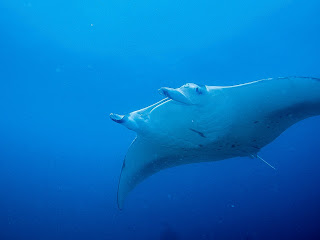Great news and a step forward for Gili Lankanfushi in cooperation with Ocean Paradise Dive Centre. We have submitted a data-set on Manta Ray sightings at Manta Point dive site for the whole of the year 2012. For your attention we also attach a graph with the manta encounter chance for the dives that we undertook at Manta point during different months of the year. Just as the last year, unfortunately manta rays did not come during the expected “Manta Season” for the eastern edge of Maldivian atolls (May to October).
This change in Manta ray migrations is though to be due to the decline in plankton due to the weakening of the monsoonal winds, ultimately because of climate change.
We have received informative feedback from Manta Trust about our sightings, and they inform us that Manta Point is an important courtship and mating site for Maldivian manta rays. Their data has shown much less breeding behaviour in last three years, this again is likely to be associated with lack of food (plankton) due to monsoonal wind weakening. Ultimately this means less mantas visiting Manta Point. Also there is a lot of diver pressure at Manta Point. At Gili, Ocean Paradise dive centre promotes diving in small groups, and has strict diving rules for Manta Point.
We will continue collecting data in 2013 and it will be interesting to compare the two data-sets. For the changes in Manta seasons here in Maldives please see an article by MantaTrust here.
Why is research on Manta Rays so important ?
Manta rays are among the most magnificent creatures of the ocean; unlike most other rays (which stay/feed close to the seabed) , mantas spend all of their life time in the mid-water, and filter feed on plankton (small animals that live freely in the water column). Fascinating enough, they can grow up to nearly 7 meters wing-span and 2 tonnes in weight. Scientists still know very little about mantas, and the majority of the research into manta biology began just over a decade ago.
It is known today that they have the largest brain of all the fish, take 8-10 years to reach sexual maturity. When mature, a manta can only produce around one offspring every 2-5 years, and the animal can live 50 to 100 years. Only in 2010 Scientists found out that there are two species of manta ray – oceanic manta (large and highly migratory), and reef manta (smaller, more restricted in its migrations).
Lastly, and sadly, Manta Rays are under a great threat from a hoax Chinese Medicine (which is made from manta gill rakers). This is a modern day hoax as there is no scientific proof that it works, and more – there are no records about gill rakers in the Traditional Chinese Medicine (TCM) books. Sadly the hoax results in over 3400 oceanic manta rays & over 94 000 devil rays (close relatives of mantas) being killed every year to supply the demand for the gill raker trade. With very long lifecycles, low reproductive output, and an unknown natural population size the manta rays can be potentially driven to extinction by this inconsiderate industry.
Speaking in terms of money, the global gill raker trade has an estimated annual value of 11 million USD. In comparison to that, the estimated annual global tourism value of the manta rays is 100 million USD.
Inquisitive giants…
Finally we would like to share a short clip of a reef manta coming to inspect our marine biologist during a dive at Manta Point. We guess there is a special connection there ;).
